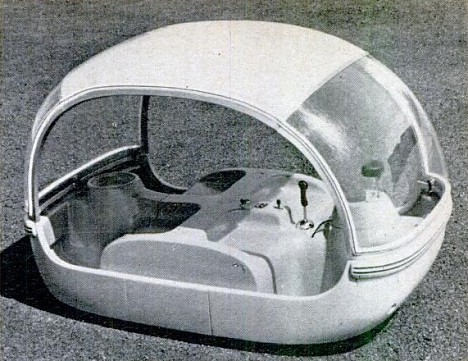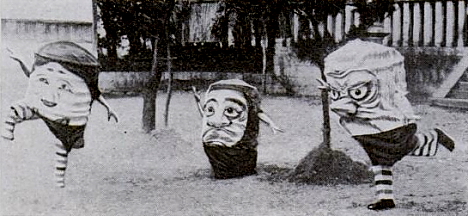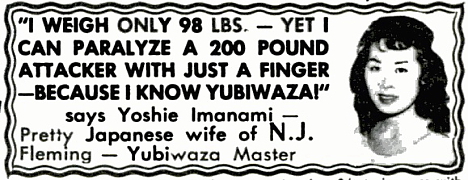Popular Science recently put its entire 137-year archive online. Here are a few summaries of some of the older, more captivating stories about Japan from the collection.
* * * * *
"Can We Blast Japan from Below?" (January 1944) is an article by an eminent geologist who proposes bombing Japan's volcanoes as a strategy for winning the war.

Given Japan's seismic instability and the explosive nature of volcanoes, dropping bombs into volcanic craters might, in the words of the author, "cause such a vomiting of lava and ash as to hasten the day of unconditional surrender."
* * * * *
"Japanese Home Life" (May 1893) examines daily domestic routines, including the telling of ghost stories around the fireplace at night. The article includes a spooky tale about shape-shifting badgers.
* * * * *

The January 1971 issue includes a short article about a "Wankel/electric hybrid concept car from Japan," an environmentally-friendly urban transport vehicle that resembles a helicopter cockpit.
* * * * *
"Upside-down Skyscrapers Proposed in Japan" (January 1929) describes a proposal to build an 80-floor subterranean building that descends 1,100 feet below ground. The envisioned structure -- dreamed up by architects seeking earthquake-proof designs after the Great Kanto Earthquake of 1923 -- would include electric lights, telephones and high-speed elevators, and would cost an estimated $11 million to complete.
* * * * *

"Nasty Job This -- Cleaning Customers' Ears" (October 1917) takes a brief look at what used to be a common service provided by Japanese barbers.
* * * * *
"Odd Rules Hamper Our Cars Abroad" (October 1930) examines some of the peculiar difficulties that American automakers faced when trying to sell cars abroad. In Japan, for example, the law used to forbid private citizens from owning maroon-colored cars -- this color was reserved for the royal family. Yellow cabs also proved to be unpopular because, according to the article, the color is associated with mourning. Japanese laws also required tail-light switches to be located at the rear of the vehicle, and special mudflaps had to be attached whenever it began to rain (to prevent pedestrians from being splashed). Taxis also had to be outfitted with two horns -- an electric horn and and a bulb horn -- and it was customary for each taxi driver to employ an assistant whose primary duty was to operate the auxiliary horn as they sped through the streets.
* * * * *
"Strange Medicines" (October 1887) discusses the spread of Western medicine through Japan. The author explores the back streets of Osaka in search of traditional medicine and explains, among other things, the old-school trade of kuroyaki (charred animals).
* * * * *
"Japan's Greeting to the New Year," (May 1921) briefly describes a Japanese New Year practice where children put on fantastic masks made of paper.

According to the article, the symbolic masks often represent traditional figures and "have a special meaning, other than just being grotesque."
* * * * *
"Animal and Plant Lore" (July 1891) examines the use of human saliva in various forms of folk medicine from around the world. The article presents a Japanese folk remedy for curing the numbness in the lower extremities that inevitably occurs when sitting too long with legs folded in the traditional formal style. To restore feeling in your legs, you should wet a piece of straw with saliva, stick it to your forehead, and chant "shibire kyo e agare" -- lit. "numbness, go up to Kyo (Kyoto)."
* * * * *
The February 1964 issue includes a long and wordy advertisement for a $1.98 booklet that teaches the secret art of Yubiwaza, an easy-to-master self-defense technique that turns one's finger into a powerful weapon.

According to the ad, Yubiwaza is an "effective means of defense against hoodlums, bullies, wise guys and juvenile delinquents who respect neither lives nor property."

erika
Why are the folks in the photo for 'Nasty Job This -- Cleaning Customers' Ears' wearing Chinese-looking clothing??
[]koNko
Because they are Chinese not Japanese. See my other comment elsewhare, Ear cleaning is practiced in both China and japan, the original practice should be from China where it is still very commonplace. I love to have this when I get my hair washed & cut. Very nice!
[]alan
"Yellow cabs also proved to be unpopular because, according to the article, the color is associated with mourning."
That's weird. Here in the UK, taxi cabs are black, which is obviously associated with mourning, but we don't think twice about it.
[]Bri
Awesome!
However, I was always told that the way to cure numbness when sitting seiza was to lick your finger and touch it to your forehead three times - maybe the custom was changed when people stopped having straw laying around? Haha!
[]sixmats
Don't they still clean ears? What is my barber doing that for?
[]ANon
If that was how they cure numbness then let's get the hell out of Kyoto! Perhaps the numbness is still there and is waiting for victims! just like the other urban legends.
And for the Yubiwaza, It does work perfectly. All you have to do is to stab your attacker's eye or b*tthole with your finger. Try not to get killed first.
[]derek
Great stuff!!! It's very telling of the general ignorance of the period, the photograph used in the ear cleaning passage is clearly chinese, you can tell by the clothing worn by all three people in the photo (especially the footwear). It was common in turn of the century reporting to lump "orientals" into one bucket and mix-match photos.
[]D
Wow! Great finds! very strange and peculiar.
btw, is Yubiwaza? real? I'd never heard of this martial arts and I can't seem to find any definitive information.
[]koNko
Ear cleaning by barbers is still a very common practice in China and by some good barbers in Japsn, and there are special tools made from bamboo and feathers for this.
I really like this, if you have never tried it you cannot understand why. And it really takes a lot of skill, the ear is a delicate thing.
[]